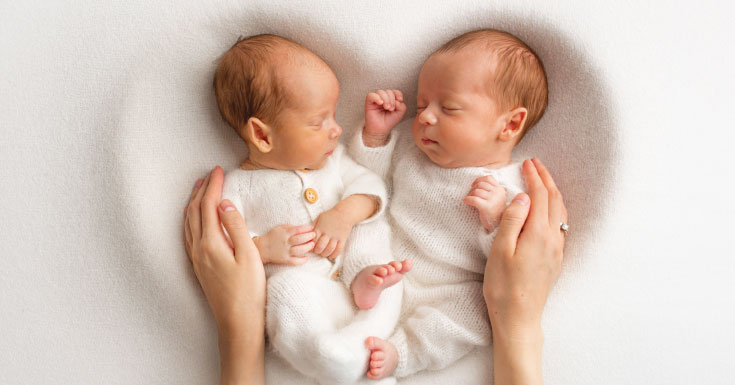Expecting more than one baby can be a great blessing and an exciting journey. However, you will have different needs as well as health risks compared to women with a single pregnancy. As a soon-to-be mother to twins, triplets or more, understanding and learning the unique risks of your multiple pregnancies while maintaining a healthy balance will ensure a safer delivery. Dr Nor Idayu Bte Ahmad Ruslan, O&G Consultant at Pantai Hospital Ayer Keroh, discusses the differences in care and experience for women with multiple pregnancies, distinction in labour and delivery, and postpartum care.
Multiple pregnancies occur when one fertilised egg (ovum) splits before it implants in the uterine lining or when a different sperm fertilises two or more separate eggs simultaneously. These two different types of multiple pregnancies result in either identical or fraternal siblings. The most common type of multiple pregnancies are twin pregnancies. Generally, a fraternal twin is more common than an identical twin, occurring in 3-4 in 1000 deliveries worldwide.
Multiple pregnancies can easily be diagnosed by using an ultrasound. The first-trimester ultrasound is essential in determining the number of babies, types of chorionicity (either the baby has her own or sharing a placenta) and amnionicity (either the baby has their own or sharing sac of amniotic fluid)
Birth Options
The decision as to whether to plan for a vaginal birth or a caesarean birth will depend on several factors, including the position in which the babies are lying in your uterus, how well the babies are growing, any comorbidities and your personal preferences about the birth. Both vaginal birth and caesarean birth have benefits and risks, depending on your individual circumstances.
In a twin pregnancy, you can opt for a vaginal delivery if the baby lying nearest to your cervix (the leading twin) is head-down, and you have no other complications. The position of the second twin can change after the first baby is born and should not influence how you choose to give birth.
If the baby nearest to your cervix is bottom-down (breech) towards the end of the pregnancy, Caesarean birth is usually recommended. A Caesarean section is the best option if you have a monoamniotic twin (when your babies share the same amniotic sac) or triplet. Discuss with your obstetrician regarding your delivery options so that you can have the safest birth plan for you and your babies.
Complications and Common Symptoms
Most women with twins or triplets have a healthy pregnancy and will give birth to healthy babies. However, complications are more common, and you will be offered extra care during your pregnancy. Some of the conditions that may occur include anaemia, pre-eclampsia, gestational diabetes, risk of delivering prematurely and postpartum haemorrhage.
Problems that many pregnant women experience, such as morning sickness, heartburn, swollen ankles, varicose veins, backache and tiredness, will also be doubled or tripled in mothers with multiple pregnancies.
Other signs unique to multiple pregnancies include excessive weight gain during pregnancy, a larger uterus, and of course – more than one heartbeat will be picked up during Daptone or multiple body part felt during an examination.
Despite being categorised as “high-risk pregnancies”, most multiple pregnancies progress smoothly. The chances of a smooth pregnancy increase if you take better care of yourself. The most important step is proper nutrition. Ideally, pregnant mothers should take a prenatal vitamin with folic acid three months prior to conception. Stay healthy and exercise regularly.
You will be in the care of obstetricians throughout your pregnancies, which means frequent follow up with serial ultrasound. Involve your partner and get their support throughout the journey. Do not be afraid to discuss any issues pertaining to your pregnancy with your doctor.
Real-Life Account Of Multiple Pregnancies
Madam AZ, an a 28 years old nurse with a strong family history of twins, was also carrying twins. The early ultrasound revealed that she has a monochorionic diamniotic twin, which means her twins shared a placenta but had different amniotic sacs. She and her husband were counselled regarding the possible outcome of twin pregnancy, like growth discrepancies and the need for regular follow-up.
She suffered from severe morning sickness during her first trimester, which warranted multiple visits to the ER and admission for intravenous hydration. Her condition improved in the second trimester. She was not anaemic, and her glucose tolerance test was normal. Her babies grew well, and a gross anomaly scan showed normal baby girls. She had regular checkups and adhered to good dietary habits.
However, during her routine ultrasound at 34 weeks, the doctor noted that her second twin was smaller with the reduced liquid. Dexamethasone was given to enhance lung maturity. The couple was counselled on the risk of intrauterine growth restriction and the risk of delivering her prematurely if there were any evidence of fetal distress. She was monitored closely for any evidence of fetal compromise.
Thankfully, her daily cardiotocograph was normal. Her babies were delivered via caesarean section at 36 weeks, weighing 2.2 and 1.8 kilograms respectively. The caesarean section was uneventful, and she was discharged after the second day of post-op. Both babies were healthy, did not require any oxygen, and were discharged on the third day.

O&G Consultant,
Pantai Hospital Ayer Keroh



